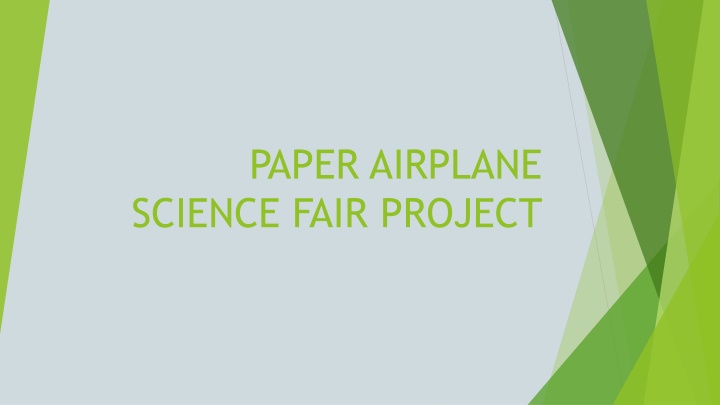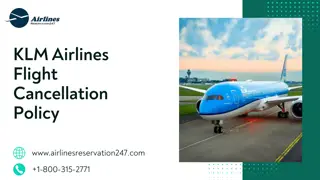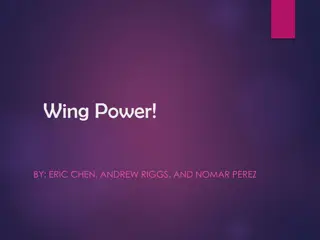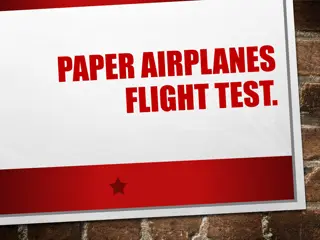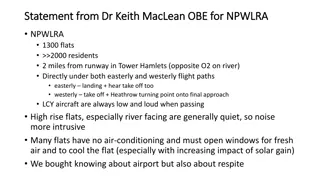Paper Airplane Science Fair Project: How Design Affects Flight
Explore how the design of a paper airplane influences the length of its flight in a science fair project. Learn about the four forces - weight, drag, lift, and thrust - that affect flight and conduct experiments to test different airplane designs. Analyze results to understand the impact of design on flight distance.
Download Presentation

Please find below an Image/Link to download the presentation.
The content on the website is provided AS IS for your information and personal use only. It may not be sold, licensed, or shared on other websites without obtaining consent from the author.If you encounter any issues during the download, it is possible that the publisher has removed the file from their server.
You are allowed to download the files provided on this website for personal or commercial use, subject to the condition that they are used lawfully. All files are the property of their respective owners.
The content on the website is provided AS IS for your information and personal use only. It may not be sold, licensed, or shared on other websites without obtaining consent from the author.
E N D
Presentation Transcript
PAPER AIRPLANE SCIENCE FAIR PROJECT
QUESTION How does the design of the paper airplane affect the length of the flight?
BACKGROUND RESEARCH What affects an airplane s flight? The four forces weight, drag, lift, and thrust affect the airplane s flight. Weight is the force that pushes down on the plane. Weight affects the plane because it pulls the plane down. Drag is the force that pulls the plane back. Drag affects the plane because it slows the plane down. Lift is the force that pulls the plane up. Lift affects the plane because it acts against weight and lifts the plane up. Thrust is the force that pulls the plane forward. Thrust affects the plane because it fights against drag by pulling the plane forward. The four forces are what affects the plane s flight.
HYPOTHESIS If the design of the paper airplane is changed, then the distance of the flight will be affected.
MATERIALS o Paper(8.5 x 11) o Pencil o Airplane Design o Scissors o Meter Stick
Procedure 1. Determine airplane design shape, paper weight, and wing length from research. 2. Create one paper airplane. 3. Partner one launches airplane one. 4. Partner 2 measures length of flight in centimeters. 5. Partner 3 records length. 6. Repeat step three three times. 7. Compared data with another group with a different airplane design.
RESULTS The paper airplanes that were made flew different distances in the experiment. Airplane one flew 925cm in the first flight. On the second flight of airplane one flew 1200cm. Airplane one flew 1580cm on the third flight. Airplane two flew 1000cm for the first flight. On the second flight, airplane two flew 1350cm. Airplane two flew 1200cm on the third flight. The paper airplanes distance s were a little different.
GRAPH AIRPLANE DISTANCES IN CENTIMETERS 1800 1600 1400 1200 1000 800 600 400 200 0 TRIAL 1 TRIAL 2 TRIAL 3 AVERAGE AIRPLANE 1 AIRPLANE2
CONCLUSION Although the distances varied, on average airplane one flew further. This happened because airplane one was more like a glider. Airplane two was like a arrowhead. Airplane one created more thrust. It created more thrust because the wind glided the plane. Airplane two created more drag. It created more drag because the wind blew the plane the wrong way. Airplane two won against airplane one in the first and second trial. Airplane one got the furthest distance in trial three and in all.
FUTURE RESEARCH What type of plane can carry the most weight?
RESOURCES Brain Pop/Flight Alex Deahr How do airplanes fly by Dr. Hany Farid Bill Nye The Science Guy Flight
